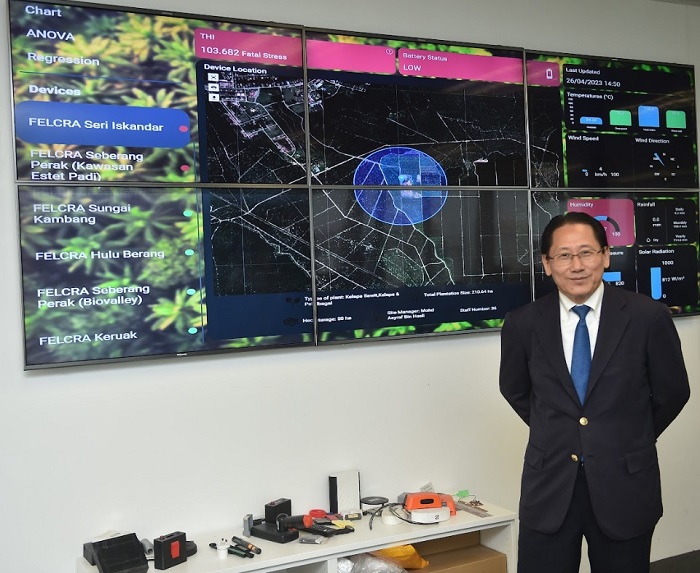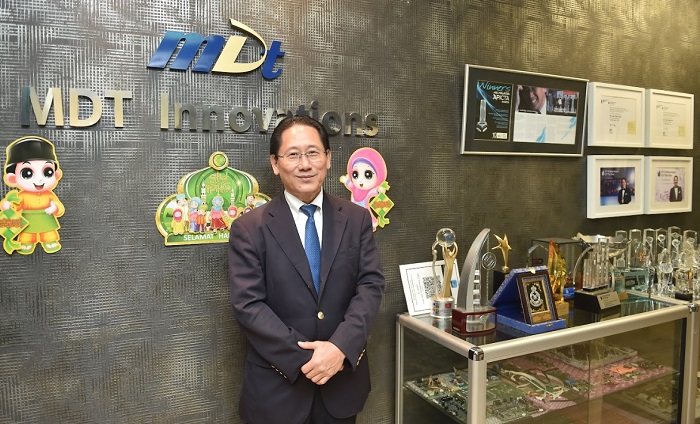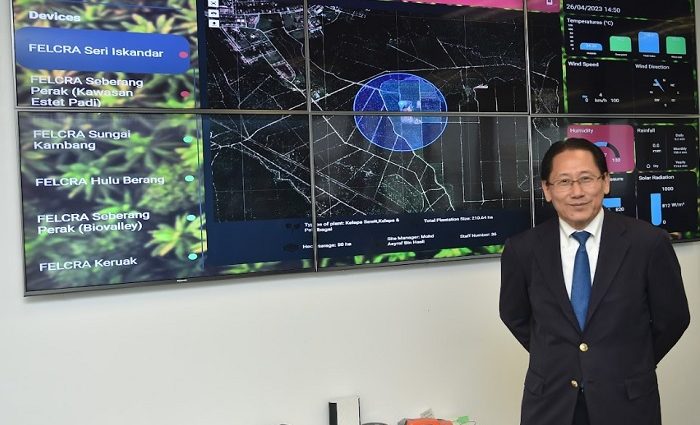- Invested over US$22.4 million in R&D and deals since 2004
- First RFID module became’s world smallest by a wide margin

Being an innovator is tough. Being an innovator in a market that is sceptical of home grown innovation can be brutal. Being an innovator in technology in a sceptical market is almost a mission impossible.
That is the crucible Malaysians who are innovating in technology face.
Liew Choon Lian, the low key founder and Group CEO of Internet of Things (IoT) specialists, MDT Innovations Sdn Bhd (MDTI), faced this when his first product, an RFID (Radio Frequency Identification) module backed by two patents, struggled to get traction in the Malaysian market.
An RFID module is a key component of an end device that can be a RFID reader or RFID gateway.
It was 2007 and the fingernail sized RFID module was not only the world’s smallest, it blew the competition out of the water.
Liew benchmarked against top European and US companies, including one German company that claimed to have the world’s smallest RFID module. “But ours was 10 times smaller,” Liew states. For power consumption, the module used 1/6th the power of other modules.
For pricing, Liew benchmarked, not against the western competition, but against the Chinese. “Those days RFID readers were very expensive, costing up to UDS$399 a module while the cheapest ones were around US$75 in China.” MDTI’s module cost a jaw dropping US$5. At this stage the company had 11 engineers spread over Malaysia, Taiwan and Japan.
While MDTI eventually broke into the Malaysian market with some leading semiconductor players using their module, this was only from 2012. Pushing for sales back then, Liew tapped his global network that he built in his previous job at Panasonic Japan, and got traction in the China market.
“Malaysia is a non-market for us, I used to say back then,” says Liew who splits his time between Japan and Malaysia. He still says that today. MDTI hit US$77.7 million (RM347 million) revenue (audited) in 2022 with only 5% coming from Malaysia.
[Ed: Para and headline updated to reflect the correct audited revenue for 2022.]
Innovation never the challenge , rather hardware focuses business model was
Being innovative was never the challenge for Liew. While it is a corporate cliche that every company likes to proclaim itself innovative, MDTI can point to a portfolio of 42 Intellectual Property (IP) filed across 11 countries, with 32 awarded and the rest pending.
The challenge was rapid revenue growth. The company hit RM100 million revenue in 2015, nine years after launch. By Malaysian standards that was very good for a tech company, but Liew was building a global company, and getting impatient. He realised its business model was the challenge. Being a hardware player meant margins were dictated by volume and it is not often one can get a large customer order.
Despite the fact that MDTi earns very high margins for its RFID Gateways and RFID Readers, the problem is that this is not a high volume game. “One RFID reader can be used to monitor up to 10 million tags,” he says, and the readers don’t wear out easily which means replacement orders are few and far between.
The solution was to become an end-to-end full-fledged IoT player instead of just an RFID company. This transition started in 2016. From developing intelligent wireless sensors to offering IoT as a service and data analytics, Liew, his right hand man, Sim Hon Wai and engineers at MDTi are now making waves in the US$46 billion smart sensor market with Asia accounting for a sizable 20.4% of the market.
“The market started taking us more seriously as well,” notes Liew. They were not just a hardware company anymore, but an end to end provider with software capabilities as well.
While there are many players in the market who claim the same but very few come from a hardware background, which Liew says gives MDTI a capabilities edge. “Our engineers based in Taiwan and Malaysia are so good that they can take a PIC Micon (a blank chip), write algorithms for amplifying circuit, and resonating circuit, and embed them into the Micon, turning it into a RFID module. We can create a middleware and integrate the software layer to the front end as well.”
Today, MDTI focuses on entire IoT value chains, ranging from intelligent wireless communications to analytics solutions. Its solutions are used in asset tracking in telecommunications, financial services, education, hospitality, agriculture, and many other sectors.

A high performer’s journey
Liew has always been a high performer, starting from when he was a straight A’s student in Kuala Lumpur, receiving a scholarship from the Ministry of Defence Malaysia in the early 80s.
Graduating with a triple major – in 2.5 years while taking seven classes per semester- and notching a CGPA of 3.9 in the US, he had scholarship money left over which he then tapped to pursue his Masters in Computer Science at Monmouth University, New Jersey while holding a job as Resident Assistant (akin to a dorm monitor) and teaching assistant.
“I was very popular with the Malaysian students then as I would pay for meals wherever we got together,” he recalled, laughing.
On graduating, he had a pick of four job offers including from IBM and AT&T Bell Labs but he chose Fuji Keizai in the US, which was a market intelligence company only serving Japanese multinationals in the US.
“All my classmates chose the engineering pathway and I asked myself if I wanted to spend the rest of my life writing code and doing R&D in a lab? So I choose to be a manager,” he explained of his choice.
His next job saw him move to Osaka, Japan in 1994 at age 33, working for Panasonic where the fluent Japanese speaking Liew rose within his second year to become general manager for global operations, overseeing 17 factories worldwide. He was already a global Malaysian before the phrase became vogue in Malaysia.
It was in the late 1990s that Liew came into the radar of the late Othman Yeop, the first Chairman of Multimedia Development Corporation who was using the launch of the Multimedia Super Corridor (MSC) to excite and convince top Malaysian talent residing overseas to return to Malaysia and help build the country’s technology capabilities.
Liew was non-commital to the first overture but the seed had been planted and when he quit Panasonic in early 2000, he started his first company in Malaysia the same year, MDT Sdn Bhd. MDT Innovations was started four years later with a focus on RFID.
On his reason for focusing on RFID, Liew explains, “I first read an article in 2003 that Walmart was about to make it mandatory for its top 200 vendors to implement RFID. Then I read about Gillette and P&G doing the same and about Microsoft forming an RFID division as well.” That was enough validation for him that something big was going to hit.
Timing and relationships then worked in his favor.
A year later in Japan, a consortium of companies was forming RF Japan Co Ltd to develop a much smaller and more powerful RFID device than what was in the market. As luck would have it, some ex colleagues from Panasanic were involved in this, and, MDTI despite being an unknown player in the space but with Liew’s corporate reputation from his time at Panasonic, became one of five companies (the only non-Japanese company) invited to be part of the consortium with each contributing 2 million yen (US$14,950) for initial operating costs.
RF Japan was formed in 2005 with Shimadzu (a leading manufacturer of medical equipment); Hirata (Japan’s largest manufacturer of display infrastructure), Panasonic, Hokshin and MDTI.
Liew and a handful of his engineers spent a week in Japan on an intensive deep dive into the technical intricacies of RFID.
“From knowing nothing about this space, we picked up the knowledge – us, a bunch of talented Malaysian engineers – and building on this foundation by 2007 we had tested and designed our first RFID module that became a world beater,” said Liew whose pride in the achievement sees him carrying the fingernail size module in his wallet, like a proud father carrying a pic of his first born, happy to show it off any chance he gets.
Covid, a catalyst for new business ventures
His RFID module now shares wallet space with Liew’s latest innovative pride, a patent protected RFID tag called Linotag that is part of the next big business targeted by MDTI under its Linen Management System (LMS) where it leverages IoT and big data applications to create RFID tags for monitoring beddings and towels used in hotels and hospitals.
Dubbed as the “Linotag connected apparel,” Liew explains that this cutting-edge IoT design uses a special kind of yarn as a wireless antenna that can withstand repeated high temperature washing.
“These tags are heat resistant, can sustain up to 60 bar pressure, and are able to withstand a high number of wash cycles.”
Linotag is actually a 10 year old system whose time has come, thanks to the pandemic sending the hospitality and healthcare sectors looking for ways to improve their efficiencies and reduce cost.
“We developed Linotag in 2014 and filed for a patent in 2015 but just like the initial RFID module, this was a hardware play with low margins,” says Liew.
Hit badly during Covid-19 pandemic with delays in chipset delivery, project postponements by clients, and facing difficulty in receiving payments, MDTI charted a new path by creating an ecosystem consisting of logistics and inventory management that would enable easy tracking and tracing of linen items for the healthcare and hospitality sectors – enter the LMS.
“We embedded our technology to enable easy tracking and tracing and we provide our customers with a service,” Liew said.
The benefits to customers include alleviating their capex burden as MDTI owns the linen, specifically bed and pillow sheets and blankets; significant reduction in labor costs as manual counting of the linen leaving premises for cleaning and their return is no longer needed; and time savings through scanning of the Linotags. “This also enables easy auditing of our clients’ inventory, as our system provides a report that indicates the wear and tear of each linen,” says Liew.
A successful pilot with a major hospital in the Klang Valley saw the system implemented in five hospitals in Malaysia, including University Malaya Medical Centre, Avisena Hospital, Nilai Medical Center, and Bukit Tinggi Medical Centre.
The sales strategy is not to go direct but partner with a party already entrenched in the hotel business. In Indonesia, MDT has partnered with the Hermina Hospital Group, and currently, 28 hospitals have adopted the system, with plans to add 50 more hospitals.
Liew has ambitious targets for the hospitality sector and aims to sign up with 100 hotels in Malaysia, Thailand, Jakarta, and Bali by 2024.
Aside from hotels and hospitals, the company is currently venturing to provide RFID tags for factory worker uniforms. It has partnered with Infineon in Malaysia for this and is looking to capture the airline industry next. “There are more compelling reasons for us to sell our LMS system to the airlines as they have stringent standards to adhere to. Uniforms that are washed too many times tend to be less fire resistant, therefore our tracking system would prove to be useful for this industry,” Liew said.
It is tempting to scoff at the thought of a technology company being in the “linen business”, even with a high tech layer but indicative of the market potential is a estimated RM150 million contract that MDTI has signed with the largest laundry operator in Vietnam where it is helping them supply and commission a modern “digital laundry” with LMS as the backbone and with customised solutions to improve efficiency.
But Liew is already looking beyond this deal. “They have a lot of hotel and hospitality customers across Vietnam that we are hoping to target for our LMS as well. I am targeting 100 hotels in Vietnam to use our LMS.”
As if he doesn’t have his hands full already with hitting his target of RM400 million revenue by end 2023 and exploding options to raise funding either via IPO or venture capital, Liew is running a pilot in the agriculture space with the Malaysian government. Similar cattle monitoring IoT based systems with AI do exist in Israel, Australia and New Zealand, “and those are too expensive for our farmers,” notes Liew on his motivation to devote resources to create his own system. “It is also about food security,” adds the Royal Military College (RMC) alumni, determined to play his part to make the nation more secure.
During the pandemic, the Ministry of Agriculture was searching for solutions to monitor the crops and cattle of its agencies, Mardi and Felcra. MDTI had already been conducting research and development on embedded sensors and AI tags for this purpose since around 2018, and was tasked with working specifically with Mardi for cattle monitoring. This involved embedding sensors on the necks of cows to monitor their health conditions and movements when they are let out in the field.
MDTI has used its sensors to create a system that recreates a suitable environment for imported cattle from Australia and India to acclimatize and thrive.
“Malaysia imports the majority of its cattle from these two countries, and the life cycle of these cattle is no longer than three to four years as the local climate is not suitable for them. Our sensors enable farmers to recreate an environment that is conducive to the flourishing of these cattle,” Liew said.
MDTI’s charging model for cattle monitoring is based on a metric the farmers understand well. Milk. “We tell the farmers we can improve the productivity of each cow by 25% and our price per cow is based on a certain amount of litres of cow milk,” says Liew.
Lesson learnt
When asked about lessons learnt during his 24 year entrepreneurial journey, Liew highlights sustainable spending on R&D. While investing in R&D has been one of the cornerstones of MDTI’s success, as it enables the firm to stay abreast of competitors, the reality is that many R&D projects will fail. “We have seen a lot of companies come and go.” Liew pins his belief in R&D investing to his Panasonic experience.
MDTI has invested roughly RM100 million in its history mostly in R&D and also in investing into new business opportunities with some of these still to pay off. For instance a RM13 million investment into tiny African nation Guinea to lay the infrastructure for its national ID system. Then the pandemic hit and then a coup in 2021. The good news is that he is seeing some revenue trickle in now.
Balanced against that is an investment made into a modern smart sensor factory built in Melaka that has been generating healthy returns since production started in 2019. After years of ordering RFID tags from factories in Vietnam and China, on the invitation of a Chinese listed company which wanted a local partner that was already in the same business, Liew took up a 30% stake in the US$5 million factory, with an annual capacity of 1 billion tags/labels. Since then MDTI’s investment has increased to over RM10 million.
Nonetheless, the number of investments made over the past three pandemic years has made some of Liew’s directors nervous about cash flow though he is confident that the bets will pay off in the long term. And who knows what other verticals he will be in by then and whether MDTI could be a listed company as that is one of the funding options he is looking at now.
“It is the right time to put the company on an accelerated growth trajectory,” he explains.
The man who graduated with a triple major, in under three years, and who became the global manufacturing head of a large Japanese company within two years probably knows a thing or two about accelerated growth.

